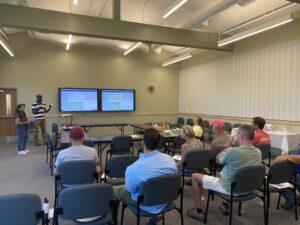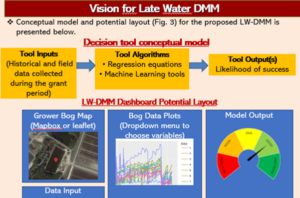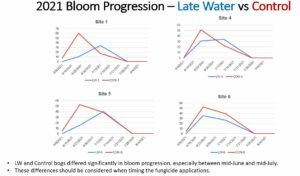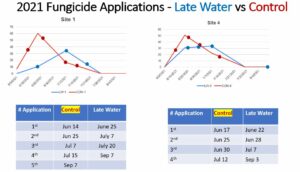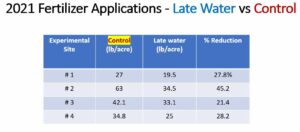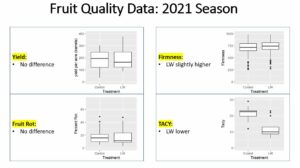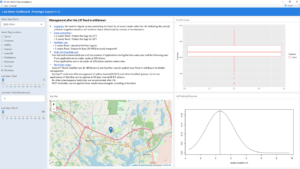Progress report for LNE21-433R
Project Information
A major and persistent challenge affecting Northeastern (NE) cranberry production is fruit rot disease. Fruit deliveries beyond 12% rot are heavily penalized, and deliveries >20% rot are rejected outright by handlers (processing industry). When Massachusetts (MA) cranberry acreage was largely planted in native cultivars (‘Early Black’ and ‘Howes’) and effective chemical control options were not available, growers relied on cultural control by late water (LW) flooding. LW is an affordable 1-month spring flooding practice, recommended once in 3 years, and is known to reduce fruit rot, insects, weeds and enhance fruit quality.
After the release of high-yielding hybrid/newer cultivars, MA cranberry acreage shifted towards these newer cultivars, which were more susceptible to fruit rot compared to native cultivars. The introduction of effective broad-spectrum protectant fungicides (mancozebs/EBDCs-ethylene bisdithiocarbamate from 1960s and chlorothalonils from 1980s), largely replaced cultural controls. Anecdotal association of LW to occasional yield losses also contributed to this shift. To produce marketable fruit, growers often apply up to five fungicides per season. Interest in LW is resurging due to the loss of key pesticides due to pesticide restrictions by international markets, rigorous fruit quality demands by cranberry handlers, pest outbreaks and historically low cranberry prices. Based on recent stakeholder feedback, >75% of decision-makers are aware of LW benefits but did not know how to decide when and/or where LW could be most beneficial. No previous research has determined which factors contribute to LW outcomes. In our extension meetings, >65% of growers expressed interest in implementing LW given the proper guidance and confidence.
We hypothesize that biotic and abiotic factors affect LW results and that these factors can be quantified and evaluated. We propose to identify the critical criteria that drive the results of LW and develop a web-based, data-driven, decision-making model (DMM) that produces grower-friendly output. For this, our multi-disciplinary team will work collaboratively with growers for three years on 15 paired sites (unflooded versus LW, 5 sites per year) and collect data for explanatory (e.g., historic and present crop data, plant carbohydrate status, water quality) and response variables (e.g., yield, fruit quality). We will analyze data using crop simulation modeling and identify the critical factors that are associated with successful LW, their relative contribution and interrelationships, and develop a LW-DMM. A LW-DMM would improve grower confidence and facilitate increased adoption of this under-utilized practice. Farm profitability will be enhanced through sustainable production, reduced pesticide applications, reliable fruit quality and reduced penalties/load rejections.
We will disseminate results to the grower-industry-scientist network through education outreach with fact sheets, peer-reviewed publications, digital resources (e.g., webinars, ScholarWorks, social media), and extension meetings. We will gather feedback from the Advisory Committee (AC) and early adopters on the initial model and integrate improvements.
To evaluate the relative importance of critical criteria (e.g., field characteristics, water quality, crop status, pest and yield history, and environmental conditions) that contribute to the short- and long-term outcome of late water (LW) floods and to develop a web-based, data-driven, decision-making model (DMM) that will generate grower-friendly outputs that promote appropriate LW use. A LW-DMM would improve cranberry grower confidence and facilitate increased adoption of this under-utilized practice. Farm profitability will be enhanced through sustainable cranberry production, increased revenue, and reduced pesticide applications. This could positively impact >420 farms in the Northeast (NE), affecting >16,000 acres of cranberries.
Massachusetts is the second-largest producer of cranberries in the U.S. with 5666 hectares (14,000 acres) in production, worth approximately $ 68,000,000 (USDA-NASS, 2018). MA cranberry farms (also referred to as bogs) are small in size with >70% of growers farm 20 acres or less. Fruit rot complex (associated with > dozen taxonomically diverse fungi) has been the major challenge in cranberry cultivation, resulting in 50-100% yield losses if not managed strategically. Fruit rot infected lots beyond 12% are heavily discounted and lots with >20% are not accepted by cranberry handlers. Historically when growers were largely cultivating native cultivars (Early Blacks and Howes) they relied on cultural management methods (late water flooding, pruning and sanding) for fruit rot. The native varieties are relatively low yielding and tolerant to fruit rot compared to the newer cultivars/hybrids. After the release of high-yielding hybrids such as BenLear (released in 1900) and ‘Stevens’ (released in 1940), the acreage shifted towards these hybrids. Based on the 2017 data sourced from OceanSpray, the largest grower co-operative representing approximately 60% of the MA acres, only 43.3% of the MA acreage is under native cultivars. 39.7% of the acreage is under Stevens and BenLears. When the effective chemicals (broad-spectrum chlorothalonils and mancozebs) were made available, growers started relying on them for managing fruit rot. In a typical commercial setting up to 5 fungicide applications/season are made, raising the cost of cultivation enormously.
For the past two decades, >90% MA cranberry acreage received chlorothalonil fungicides, making them key fruit rot management tools. In 2019, export markets targeted chlorothalonils for elimination and lowered maximum residue limits (MRLs) from 5 to 0.01 ppm. Since approximately 30% of the North American cranberry crop is marketed in the European Union (EU), most handlers imposed restrictions to meet international standards. Researchers and growers started the year 2020 considering the alternate options (the only other registered effective broad-spectrum fungicide group mancozebs; and single-site mode of action fungicides from FRAC group 3 & 11). On April 21, 2020, we received notification from the US trade policy office that the EU notified the World Trade Organization (WTO) of its intent to not renew the approval for use of mancozebs. Under this scenario, after February 2021, growers will be left only with Group 3 & 11 fungicides, fungal resistance of which is well documented in various cropping systems. Due to the intricacies of the fruit rot complex, it takes a long time and countless resources to screen and ultimately successfully secure new fungicide registrations. For the long term sustainability of the cranberry industry, it is essential that we reduce overreliance on chemicals and diversify the fruit rot management tool kit with eco-friendly, cost-effective, cultural measures. Especially due to the current historic low cranberry prices, rigorous fruit quality demands by handlers and pest outbreaks, there is a renewed interest in growers for low-cost, sustainable measures.
LW has been previously evaluated and proven to reduce fruit rot, pests, weeds and improve fruit quality on native cranberry cultivars. We do not know if these data accurately describe the response of hybrids. Given the proper guidance and confidence, several growers are willing to adopt LW for fruit rot management. Previous researchers have focused on individual aspects of LW outcomes (e.g., cranberry insects, fruit rot, or non-structural carbohydrates) over a single cropping season. We propose a multi-year, multi-disciplinary study with a broad scope. We proposed to identify critical criteria that influence the favorability of LW using on-farm research data as well as the historical records to develop a DMM. If our DMM accurately predicts the risks and conditions that would maximize success with LW, pesticide inputs and the cost of cranberry cultivation would be significantly reduced.
For the past three growing seasons we studied 15 paired sites (late water held vs control sites) and gathered information on fruit quality, weather and cultural practices data. We are analyzing all the data now with an objective to develop a late water decision making model.
Cooperators
- (Educator and Researcher)
- (Educator and Researcher)
- (Educator and Researcher)
- (Educator and Researcher)
- (Educator and Researcher)
- (Educator and Researcher)
- (Educator and Researcher)
Research
2021 Studies: In April 2021, 5 paired sites of LW flooding versus unflooded control beds of ‘Stevens’ were selected in collaboration with our Advisory Committee and other willing MA cranberry growers to evaluate relative contribution and interrelationships of various field level variables on LW outcomes, both for intended benefits (e.g., reduced fruit rot incidence, improved fruit quality, reduced cost-of cultivation) and potential negative effects on plant health and crop yield. Each of the paired sites were labelled as Late Water/LW and Unflooded/Control/CON (2021-LW-1/2021-CON-1 were located in Plymouth; 2021-LW-2/2021-CON-2 were located in Carver; 2021-LW-4/2021-CON-4 were located in Wareham; 2021-LW-5 & 2021-CON-5 were located in Wareham; 2021-LW-6 is in Carver & 2021-CON-6 were located in Middleboro). Each of the paired site LW bog and unflooded controls were very close to each other (less than 0.25 miles distance) except LW-6 & CON-6 which were 4 miles apart. From all of the participating growers data pertaining (yield, fruit rot%) to participating bogs for the past five years was collected. Participating growers at the selected bog sites held late water floods from April 15 to May 15th. From May 15th to August 2021, all the sites were visited on a regular basis, bloom progression between late water and unflooded bogs were recorded. In June and July, from each of the sites tissue samples for nutrient content analysis and total non-structural carbohydrate analysis were collected. Samples were also collected and processed for Reproductive vs Vegetative upright ratio.
We had our first official advisory committee/key professionals/grower participants official meeting on June 4th, 2021 to discuss the materials and methods of the project, hypothesis to be tested, proposed plan of action.
In Late September, 2021, fruit samples from all the participating paired sites were collected. In October and November, 2021, fruit samples were processed for fruit rot%, yield, fruit quality estimations. In December, 2021, regional spatial datasets of climate, weather were collected for inclusion in data analysis.
2022 Studies: In April 2022, 2 and 3 paired sites (LW flooding versus unflooded control beds) respectively of cranberry cv. 'Stevens' and 'MullicaQueens' were selected in collaboration with our Advisory Committee and other willing MA cranberry growers to evaluate relative contribution and interrelationships of various field level variables on LW outcomes, both for intended benefits (e.g., reduced fruit rot incidence, improved fruit quality, reduced cost-of cultivation) and potential negative effects on plant health and crop yield. Paired sites were labelled as Late Water/LW and Unflooded/Control/CON (2022-LW-1/2022-CON-1 in Wareham; 2022-LW-2/2022-CON-2 in Carver; 2022-LW-3/2022-CON-3 in Carver; 2022-LW-4 & 2022-CON-4 in Plymouth; 2022-LW-5 & 2022-CON-5 in Lakeville; 2022-LW-6 in Wareham & 2022-CON-6 from Carver). Each of the paired site LW bog and unflooded controls were very close to each other (less than 0.25 miles distance) except LW-6 & CON-6 which were 5 miles apart. From all of the participating growers data pertaining (yield, fruit rot%) to participating bogs for the past five years was collected. Participating growers at the selected bog sites held late water floods between April 8 to May 15th. From May 15th to August 2021, all the sites were visited on a regular basis, bloom progression between late water and unflooded bogs were recorded. In June and July, from each of the sites tissue samples for nutrient content analysis and total non-structural carbohydrate analysis were collected. Samples were also collected and processed for Reproductive vs Vegetative upright ratio.
We had our second advisory committee board meeting on April 8th, 2022 to discuss the progress of the project, timelines and proposed plan of action for the next 6 months.
We organized an in-person Bogside workshop on September 12th, 2022 at one of our participant bogs. It was attended by 26 people. During this workshop, we presented to growers on late water, factors to consider before holding late water, known benefits of late water, when not to use late water, management practices to follow after late water floods are withdrawn and demonstrated our vision for late water decision-making model and a initial draft prototype. We also presented growers with the data from 2021 field studies. We provided a handout of the information we presented to growers.
In Late September, 2022, fruit samples from all the participating paired sites were collected. Between October, 2022 to January, 2023, fruit samples were processed for fruit rot%, yield, fruit quality estimations. In January, 2023, regional spatial datasets of climate, weather were collected for inclusion in data analysis.
2023 Studies: In April 2023, 2 paired sites (LW flooding versus unflooded control beds) each respectively of cranberry cv. 'Stevens' and 'MullicaQueens'; one paired site of cranberry cv. 'CrimsonQueen' were selected in collaboration with our Advisory Committee and other willing MA cranberry growers to evaluate relative contribution and interrelationships of various field level variables on LW outcomes, both for intended benefits (e.g., reduced fruit rot incidence, improved fruit quality, reduced cost-of cultivation) and potential negative effects on plant health and crop yield. Paired sites were labelled as Late Water/LW and Unflooded/Control/CON (2023-LW-1/2023-CON-1 in Wareham; 2022-LW-2/2022-CON-2 in Plymouth; 2023-LW-3/2023-CON-3 in Marion; 2023-LW-4 & 2023-CON-4 in Wareham; 2023-LW-5 & 2023-CON-5 in Carver). Each of the paired site LW bog and unflooded controls were very close to each other (less than 0.25 miles distance). From all of the participating growers data pertaining (yield, fruit rot%) to participating bogs for the past five years was collected. Participating growers at the selected bog sites held late water floods between April 8 to May 15th. From May 15th to August 2023, all the sites were visited on a regular basis, bloom progression between late water and unflooded bogs were recorded. In June and July, from each of the sites tissue samples for nutrient content analysis and total non-structural carbohydrate analysis were collected. Samples were also collected and processed for Reproductive vs Vegetative upright ratio.
We organized an in-person Bogside workshop on September 7th, 2023 at UMass-Amherst-Cranberry Station. During this workshop, we presented to growers on late water, factors to consider before holding late water, known benefits of late water, when not to use late water, management practices to follow after late water floods are withdrawn and demonstrated our vision for late water decision-making model and a initial draft prototype. We also presented growers with the data from 2022 field studies. We provided a handout of the information we presented to growers.
In Late September, 2023, fruit samples from all the participating paired sites were collected. Between October, 2023 to January, 2024, fruit samples were processed for fruit rot%, yield, fruit quality estimations. In January, 2023, regional spatial datasets of climate, weather were collected for inclusion in data analysis.
Results from the last three growing seasons are being analyzed.
Education & Outreach Activities and Participation Summary
Educational activities:
Participation Summary:
Outreach Presentations:
- https://www.youtube.com/watch?v=_YvDCQn36i8 "200 Years of American Cranberry Domestication & Status of Fruit Rot Research". Presented for BioIngene Online Webinar.
- Leela Uppala_April 27, 2021 UMass Cranberry Station's Pesticide Safety Meeting "Cranberry Fungicide Options: A Review".
- Leela Uppala- November 19th, 2021 UMass Cranberry Station's Oversight Meeting.
- Leela Uppala- December 17th, 2021 Invited Seminar "Cranberry Disease Research" to University of Wisconsin.
- Leela Uppala, Salisu Sulley, Michael Nelson- April 8th, 2022. Late Water Advisory Board Meeting.
- Leela Uppala, Salisu Sulley, Michael Nelson- September 12th, 2022. Late Water Bogside Workshop.
-
Uppala, L. S., Nelson, M. F., and Salisu, S. 2022. Studies to identify critical criteria impacting late water outcome in Massachusetts cranberry production and develop a decision-making model. American Phytopathological Society Annual Meeting. August 6th-10th, Pittsburgh, PA.
- Leela Uppala, Salisu Sulley, Michael Nelson- September 7th, 2023. Late Water Bogside Workshop.
